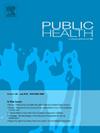1990-2021年204个国家和地区高体重指数导致的结直肠癌负担:来自2021年全球疾病负担研究的结果
IF 3.9
3区 医学
Q1 PUBLIC, ENVIRONMENTAL & OCCUPATIONAL HEALTH
引用次数: 0
摘要
目的高体重指数(BMI)与结直肠癌(CRC)之间的相关性已得到证实。然而,高BMI导致的全球结直肠癌负担仍未得到充分探讨。本研究旨在检查和分析1990年至2021年全球、地区和国家层面与高BMI相关的结直肠癌负担。研究设计:2021年全球疾病负担(GBD)研究的描述性分析。方法从GBD 2021中提取死亡人数、残疾调整生命年(DALYs)、年龄标准化死亡率(ASMR)和年龄标准化DALYs率(ASDR)数据。计算年均百分比变化(AAPC),采用Joinpoint回归分析评估ASDR和ASMR的时间变化。使用人口归因分数(PAF)分析由危险因素引起的结直肠癌负担。结果2021年,全球因高BMI导致的结直肠癌死亡和伤残年数分别为99270例和2364660年,是1990年的两倍多。高SDI区负担最重,低、中、中SDI区上升较快,以60岁以上人群和男性受影响最大。东亚,特别是中国,在全球的负担最重。ASMR、ASDR与SDI相关。2021年,结直肠癌负担的前五大危险因素是低粗粮饮食(17.72%)、低牛奶饮食(15.10%)、高红肉饮食(14.55%)、高BMI(9.69%)和低钙饮食(8.20%)。结论高BMI是结直肠癌的重要危险因素,年龄、人口增长、性别和SDI对结直肠癌负担的地理和时间变化有影响。这些发现强调了迫切需要有针对性的预防策略,特别是在高危人群中,并强调了肥胖预防、早期筛查、生活方式和饮食改变以及人工智能驱动技术等干预措施在减轻结直肠癌负担方面的作用。本文章由计算机程序翻译,如有差异,请以英文原文为准。
Burden of colorectal cancer attributable to high body-mass index in 204 countries and territories, 1990–2021: Results from the Global Burden of Disease Study 2021
Objectives
A strong association between high Body Mass Index (BMI) and Colorectal Cancer (CRC) has been well established. However, the global burden of CRC attributable to high BMI remains underexplored. This study aims to examine and analyze the burden of CRC linked to high BMI at global, regional, and national levels from 1990 to 2021.
Study design
A descriptive analysis of the Global Burden of Disease (GBD) Study 2021.
Methods
Data on the number of deaths and disability-adjusted life years (DALYs), as well as age-standardized mortality rate (ASMR) and age-standardized DALYs rate (ASDR), were extracted from the GBD 2021. Average annual percentage change (AAPC) was calculated to evaluate the temporal change in ASDR and ASMR using Joinpoint regression analysis. The Population Attributable Fractions (PAF) were used to analyze the CRC burden attributed to risk factors.
Results
In 2021, the global deaths and DALYs of CRC attributed to high BMI were 99,270 deaths and 2,364,660 years respectively, more than double the figures from 1990. High SDI regions bore the greatest burden while low-middle and middle SDI regions experienced a faster rise, with individuals over 60 and males being the most affected. East Asia, particularly China, had the heaviest burden globally. ASMR and ASDR were correlated with SDI. The top five risk factors for CRC burden were a diet low in whole grains (17.72 %), a diet low in milk (15.10 %), a diet high in red meat (14.55 %), high BMI (9.69 %) and a diet low in calcium (8.20 %) in 2021.
Conclusion
High BMI is a significant risk factor for CRC, with aging, population growth, gender, and SDI contributing to geographic and temporal variations in the burden. These findings highlight the urgent need for targeted prevention strategies, especially in high-risk populations, and emphasize the role of obesity prevention, early screening, lifestyle and dietary modifications, and interventions such as AI-driven technologies to reduce the CRC burden.
求助全文
通过发布文献求助,成功后即可免费获取论文全文。
去求助
来源期刊

Public Health
医学-公共卫生、环境卫生与职业卫生
CiteScore
7.60
自引率
0.00%
发文量
280
审稿时长
37 days
期刊介绍:
Public Health is an international, multidisciplinary peer-reviewed journal. It publishes original papers, reviews and short reports on all aspects of the science, philosophy, and practice of public health.
 求助内容:
求助内容: 应助结果提醒方式:
应助结果提醒方式:


